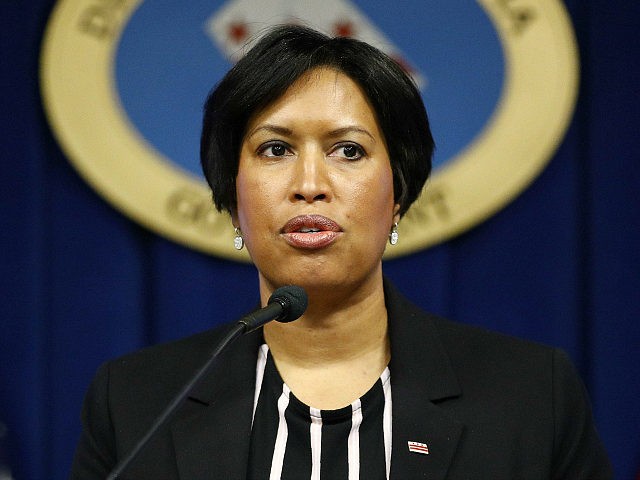Washington, DC, Mayor Muriel Bowser, on Wednesday, extended her stay-at-home order aimed at stemming the spread of coronavirus by three weeks to June 8, citing contact tracing capacity issues, and the absence of a 14-day decrease in the community spread, among other reasons.
The mayor told reporters on Wednesday,
Today, we will extend the District’s stay-at-home order through Monday, June 8. I should note that based on the data, I can revise this order at any time to reflect a phased reopening, if the data suggests that we can do that.
The original measure was due to expire on Friday. Bowser also said she prolonged D.C.’s lockdown because the District has not yet seen a transmission rate under one for three days.
Transmission rate refers to how many new infections come from each coronavirus case.
Bowser’s decision to extend the lockdown in D.C. came as the number of daily new coronavirus cases has begun to drop along with community spread and the rate of transmission, the District’s own data show.
Some projections have also predicted that although testing numbers will continue to improve in the next few weeks, the number of estimated infections (including unconfirmed mild and asymptomatic cases) will go down along with daily deaths and the use of hospital beds.
“As of Wednesday, the District is in a four-day decrease in community spread. In addition, the rate of transmission has been below one for two days, according to Bowser,” the Patch noted.
D.C.’s goal is for the transmission rate to be below one for three days. It is also aiming for a 14-day decrease in the community spread.
Referring to contact tracing issues in the capital, the Patch added:
The District’s goal is to be able to contact trace any new case within one day and their close contacts within two days. Currently, D.C. Health can contact trace for its priority populations — essential workers, at-risk healthcare personnel, etc. — and their close contacts, so it still needs to build out its testing capacity in order to handle the surge of new cases.
“This is the piece that will help us ensure that we won’t have widespread community transmissions when we see those new infections,” Bowser proclaimed, referring to contact tracing.
The mayor also acknowledged that the District is already able to test areas essential to a phased reopening, including symptomatic individuals, at-risk healthcare personnel, essential workers, and close contacts of new cases.
Nevertheless, she added:
We still, however, don’t think we’re testing all of the people who need to be tested in those four groups. We continue to reach out to people, making everybody aware of the testing locations and that those tests are free and that we’ll continue to do that.
On Tuesday, Adm. Brett Giroir, the assistant secretary for health at the U.S. Department of Health and Human Services (HHS), told a Senate panel that the Trump administration would be able to meet all U.S. testing needs for May and June.
D.C. also has more than enough beds to treat the current number of coronavirus cases, the District’s data show.
It also appears to have an adequate number of beds to deal with an expected surge of cases with a phased reopening.
“We have been very confident about the number of beds at area hospitals that are part of our surge capacity,” Bowser declared.
“Without a surge, the District needs to have its healthcare capacity at less than 80 percent over seven days. The District’s current healthcare occupancy is at 76 percent and it has been under 80 percent for 14 days,” the Patch noted.
The cumulative number of cases and deaths in D.C. do continue to rise.
D.C. marked its highest single-day number of coronavirus cases on May 1 (335 cases) and its second-highest on May 8 (245), but the figures have steadily dropped since.
The District’s number of deaths per one million residents, at 476, is also higher than the national average of 252 per one million people, Worldometer reported.
Furthermore, the number of cases per one million residents in D.C., at 9,189, is more than double the national average of 4,256 cases per one million people.
The positive rate (over 20 percent) of the total number of tests that health officials have administered in D.C. is also higher than the national average of about 14 percent, according to the COVID Tracking Project.
However, more people are testing negative (24,565) than positive (6,485) in the nation’s capital.
To begin reopening, D.C. needs “fourteen days of consistent downward trend in coronavirus cases, hospitalizations and/or the percentage of tests that come back positive,” the local CBS-affiliated TV station WUSA9 reported.
“It’s the same criteria included in the White House’s ‘Opening Up America Again’ plan,” it added. “It’s based in part on the coronavirus’ up-to-14-day incubation period.”
Based on the criteria highlighted in the White House guidelines, the nation’s capital is not yet ready to reopen, particularly given the absence of a 14-day downward trend in cases.
As of Wednesday, coronavirus had infected 6,584 people and killed 350, according to data from the capital’s health department.

COMMENTS
Please let us know if you're having issues with commenting.